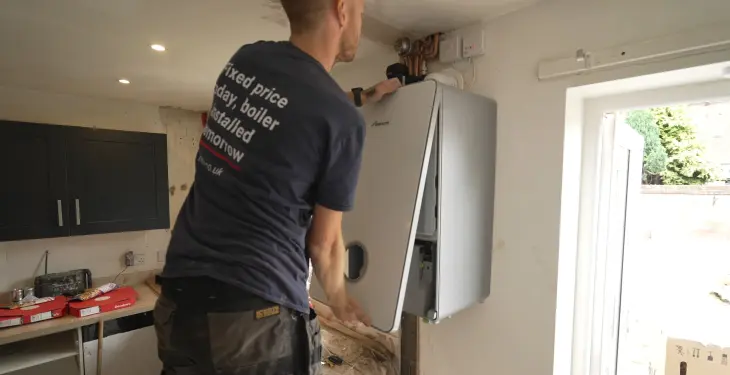

Written by Stephen Day
Gas Safe Engineer
Updated: 30th May, 2025
Hiding a boiler in the kitchen can enhance the room's aesthetic while maintaining functionality. Consulting a Gas Safe registered engineer before making any modifications is recommended to ensure compliance and safety.
Get a new boiler quote, save up to £550 per year (0% APR available).
Hiding a boiler in the kitchen can be a smart way to maintain a clean and stylish space. One of the best methods to conceal a boiler is by installing it inside a cupboard for a seamless kitchen design. This not only keeps the boiler out of sight but also provides a practical storage solution.
For those looking for a more creative approach, consider building a simple wooden box or even using a cupboard with a spice rack door to hide the boiler. These options add functionality while keeping the boiler hidden. Alternatively, adding a chalkboard to a boxed-in boiler can offer both a cover and a useful feature for notes and reminders.
If you have limited space, you could cover the boiler with a stylish mirror or use curtains as an easy and affordable way to hide it. Another clever idea is to turn the boiler into a partition between the kitchen and dining room, adding a unique design element to your home.
Get a quote in 60 seconds, fitted as fast as next day!
0% APR finance available.
One of the most effective ways to hide a boiler and achieve a seamless kitchen design is to house it inside a cupboard. This method not only keeps the boiler out of sight but also blends it with the rest of the kitchen decor.
Materials and Design
Choose materials that match your kitchen design. For a modern look, consider sleek, handleless cabinets. If your kitchen has a more traditional feel, opt for wooden panels that complement the existing design.
Ventilation and Safety
Ensure the cupboard has proper ventilation. Boilers need space for air circulation to function safely. UK regulations state there should be sufficient space around the boiler for air to circulate, and the flue should be properly vented to the outside.
Consult a Gas Safe registered engineer to ensure that your design meets safety standards and doesn’t impede the boiler’s operation.
Aesthetics
Use creative designs to make the boiler cupboard an attractive feature. Consider adding sliding doors or a chalkboard door for a functional and stylish touch.
For an industrial-style kitchen, materials like metal or glass can give the cupboard a distinctive look, making it an intentional part of the decor.
Practical Tips
Install shelves or a small spice rack on the inside of the cupboard door for extra storage.
Use a plain or mirrored door to make the kitchen look bigger and brighter.
If space is limited, consider creating a false wall to create a hidden compartment without sacrificing cupboard space.
By following these steps, homeowners can hide their boiler in a way that is both functional and aesthetically pleasing, ensuring a seamless and stylish kitchen design.
When building a simple wooden box to conceal your boiler, start by measuring the boiler and any visible pipework. Accurate measurements ensure the box fits snugly around the boiler without obstructing ventilation or access for maintenance.
Materials:
Choose sturdy wood such as plywood or MDF. Ensure that the wood is durable but not too thick to manage easily.
Steps:
Cut the Wood: Based on your measurements, cut the wood panels for the sides, top, and front of the box. Leave space for ventilation and easy access.
Assemble: Use screws and wood glue to assemble the panels into a box shape. Make sure the box is sturdy and fits around the boiler.
Hinges and Doors: Attach hinges to one side of the box to create a door, allowing easy access for servicing the boiler.
Finish: Sand the wood to remove any rough edges. Paint or stain the box to match your kitchen decor. Painting the boiler pipes and the box can help it blend in better.
Hints:
Use a spirit level to ensure the box is straight.
Magnetic catches or simple latches can keep the door securely closed.
If your boiler has visible copper pipes, consider painting them to match the box for a seamless look.
Safety Tip: Always ensure proper ventilation around the boiler and check with a Gas Safe registered engineer before completing the enclosure to ensure it meets UK safety standards.
Creating a cupboard with a spice rack door is a clever way to hide your boiler. It not only keeps the boiler out of sight but also adds additional storage for your kitchen essentials like spices.
Start by measuring the dimensions of your boiler to decide the size of the cupboard. Ensure there is enough space for ventilation, as required by UK safety standards.
Materials Needed:
Wooden panels or MDF boards
Hinges
Screws and nails
Spice rack kits
Paint or wood finish
Steps:
Build the Framework:
Construct the outer frame of the cupboard using wooden panels.
Attach the back panel to enclose the cupboard.
Install Hinges:
Fix the hinges to the side panels, ensuring they are aligned properly for smooth operation.
Attach the Spice Rack:
Select a spice rack that fits the height and width of the cupboard door.
Secure the spice rack to the door using screws.
Mount the Door:
Attach the spice rack door to the cupboard frame using the installed hinges.
Finishing Touches:
Paint or finish the cupboard to match the kitchen decor.
Safety Tip: Ensure that the cupboard design allows for proper ventilation and easy access to the boiler for maintenance. Consulting a professional before finalizing the installation is recommended.
Building a Cabinet: One way to hide your boiler is by building a cabinet around it. This can be done using wood or MDF.
Adding a Chalkboard Door: Consider painting the door of the cabinet with blackboard paint, creating a practical space for notes and reminders.
Steps:
Boxing and Painting:
Construct a basic box around the boiler.
Apply chalkboard paint to the outside, allowing it to blend with the kitchen while offering extra functionality.
Chalkboard Cupboard:
Create a cupboard with a chalkboard surface that covers the boiler while providing a place to write messages or shopping lists.
Safety Tip: Make sure the box or cupboard allows for proper ventilation and easy access for maintenance. Always consult with a Gas Safe registered engineer to ensure the installation meets safety regulations.
Covering your boiler with a mirror is a clever way to integrate it into your kitchen design, making the space look more spacious and modern.
Steps:
Measure the Boiler:
Ensure you buy a mirror that fits perfectly over the boiler.
Choose the Right Mirror:
Opt for a frameless mirror for a sleek appearance, or a framed one to match the kitchen decor.
Mounting:
Use secure brackets or adhesives that can safely hold the mirror's weight, considering the boiler's vibrations during operation.
Safety Tip: Ensure that the boiler remains accessible for maintenance. A hinged mirror or sliding design can be useful, allowing easy access without needing to remove the mirror entirely. Always leave room for proper ventilation around the boiler to prevent overheating.
Curtains can be a simple yet effective solution to hide your boiler in the kitchen. They are affordable and offer various designs to match your kitchen decor.
Installation Steps:
Measure the Area:
Measure the area around your boiler.
Select Curtains:
Choose a suitable curtain and rail or rod that complements your kitchen design.
Install:
Install the rail or rod above or around the boiler.
Hang the curtain, ensuring it fully covers the boiler.
Safety Tip: Curtains should not restrict airflow and must be positioned far enough from the boiler to avoid any fire risk. Ensure the fabric used is fire-resistant and that there’s adequate space for ventilation around the boiler.
Building a utility cupboard can effectively hide your boiler while providing additional storage.
Materials Needed:
Plywood or MDF
Hinges and screws
Measuring tape
Paint or wood finish
Handles or knobs
Steps:
Measure Your Space:
Begin by measuring the dimensions around your boiler, ensuring there's a minimum gap of 50mm to allow for ventilation.
Cut the Materials:
Cut the plywood or MDF to the measured dimensions for the cupboard's sides, top, bottom, and doors.
Assemble the Frame:
Assemble the sides, top, and bottom pieces securely.
Attach the Doors:
Fix the doors to the frame using hinges.
Add Shelves for Storage:
Install shelves inside the cupboard if needed, making sure they don’t interfere with the boiler’s function.
Safety Tip: Consult a Gas Safe registered engineer to confirm that the cupboard design meets all UK safety regulations regarding ventilation and accessibility.
Positioning your boiler to act as a partition between your kitchen and dining room can be a clever use of space.
Steps:
Build a False Wall:
Attach a piece of wood or plasterboard to create a new wall, housing the boiler while providing separation between the rooms.
Create a Central Feature:
Surround the boiler with cabinets or shelves, and consider adding a countertop for added functionality.
Safety Tip: Ensure the partition allows for proper ventilation and that the boiler remains accessible for maintenance. Follow all gas safety regulations and consult with a professional before finalising the installation.
New boilers can be a daunting purchase for many people as they’re an appliance with a lot of responsibility, providing heat for you and your family is something you want to get right. Boilers aren’t exactly a quickly disposable item either, potentially lasting you a decade.
Effectively, new boiler cost can be split into two segments: the first is the actual boiler itself (unit price), and the second is the cost of the boiler being installed (set up) in your property by an expert engineer.
Here at iHeat, we remove all of this undue stress and make the decision making process of upgrading to a new heating system, as easy as possible.
New boiler costs can vary depending on a number of factors including their brand, model, fuel, output, warranty, labour and boiler installation type. Typically a new boiler will cost between £1,845 and £3,500, below is a list of average boiler installations offered by iHeat (guide only).
Installation Type | Price (inc VAT) | |
Combi to combi swap | £1,845 | |
System to combi conversion | £2,499 | |
New boiler install | £2,899 | |
Back boiler to a combi | £3,299 | |
System to system | £1,945 |
Last updated: 30th May, 2025

Written by Stephen Day
Gas Safe Engineer at iHeat
Stephen Day is a Gas Safe registered and FGAS certified engineer with over 20 years of hands-on experience in the heating, cooling, and renewable energy industry, specialising in boiler installations, air conditioning, and heat pump systems.
LinkedInArticles by Stephen Day are reviewed by iHeat’s technical team to ensure accuracy and reliability.

22nd December, 2025
Based on data from over 7000 boiler installations completed by iHeat in the past 12 months...
 Read Article
Read Article

22nd December, 2025
Here’s a quick roundup of the best combi boilers for 2026.
 Read Article
Read Article

22nd December, 2025
When your old boiler breaks down and it comes time to replace it with a new one, it might...
 Read Article
Read Article
No obligation. Takes less than 60 seconds.